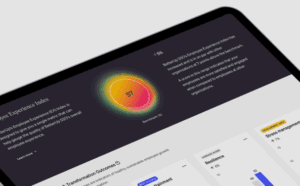Home / Blog / AI Just Got a Checkout Button: What OpenAI’s Commerce APIs Mean for eCommerce
AI digital marketing Go Fish Digital
AI Just Got a Checkout Button: What OpenAI’s Commerce APIs Mean for eCommerce
Published: October 01, 2025
Share on LinkedIn Share on Twitter Share on Facebook Click to print Click to copy url

Contents Overview
AI has already transformed how customers discover products, research brands, and compare options. But until now, the final step, completing a purchase, has still lived outside the AI experience. Shoppers might get product recommendations from ChatGPT or another assistant, but they still had to click through to a website, navigate a traditional checkout flow, and complete payment in a separate environment.
OpenAI’s new Commerce APIs change that. For the first time, AI can manage the entire buying journey in one seamless flow. With AI checkout, instant payments, and direct product feeds, the technology enables customers to discover, select, and purchase without ever leaving the conversation.
For eCommerce leaders, this shift signals more than just a new technical capability. It marks the arrival of AI-driven commerce as a direct sales channel, and it will reshape how brands think about funnels, customer acquisition, and retention.
What Are OpenAI’s Commerce APIs and How Do They Work?
The Commerce APIs are designed to let developers connect storefronts directly to AI experiences. That means a customer who asks ChatGPT for product recommendations could not only see your products but also buy them instantly without leaving the conversation.
The framework covers four main areas:
- Product feeds. Brands can send structured product data: names, descriptions, prices, availability, into OpenAI’s system, ensuring their catalog is represented accurately in AI-driven environments. Think of this as the foundation for how your products will be discovered.
- Checkout sessions. Once a product is selected, the API can initiate a checkout session within the AI itself. This reduces friction by removing unnecessary clicks, logins, and redirects that typically cause abandonment.
- Payments. The payment flow is handled natively within the AI conversation. Customers can enter details securely or use saved methods, creating a seamless, trusted experience that reduces drop-off.
- Order updates. Webhooks allow your systems to receive order and payment confirmations in real time, ensuring fulfillment stays connected with your existing workflows.
Taken together, these features collapse what was once a multi-step process into a single, uninterrupted flow. For customers, it feels effortless. For brands, it represents a fundamental rethinking of how and where conversion happens.
Why AI Checkout and Instant Payments Matter for eCommerce Growth
For years, eCommerce growth has been about finding ways to make checkout faster and easier. Retailers have optimized landing pages, experimented with one-click purchasing, and invested heavily in retargeting campaigns to win back abandoned carts. Yet even the best checkout flows still introduce friction when shoppers leave their discovery environment to finish a purchase.
By enabling AI-powered checkout, OpenAI’s APIs eliminate some of the most common points of drop-off. Customers no longer have to leave ChatGPT or another assistant to complete a transaction.
This matters because every extra step in a funnel, whether it is a page load, a login screen, or a form field, reduces conversion rates. If checkout can happen directly inside the AI experience, brands can expect fewer abandonments and higher conversion percentages.
But the impact goes deeper than funnel optimization. With fewer barriers to purchase, customer lifetime value (LTV) becomes an even more important metric. If it becomes easier to capture that first transaction, the real differentiator will be how well a brand retains customers and drives repeat purchases.
Loyal customers will compound the benefits of a frictionless funnel, while brands with weak retention strategies may see lower margins despite easier acquisition.
At Go Fish, we help eCommerce leaders adapt to the changing search and commerce landscape. If you want to understand how AI checkout and feeds affect your visibility and conversions, request an AI Visibility Audit today.
Our Take: How AI Commerce Will Reshape eCommerce Strategy
We see this as more than just another channel. It is a moment where marketing, checkout, and customer experience collide. AI-driven commerce means discovery and conversion are no longer separate stages, they are part of the same conversation.
For eCommerce leaders, that creates both opportunity and urgency. Early adopters will be able to shape how their products are discovered and purchased in AI environments. They will capture incremental sales, reduce customer acquisition costs, and build loyalty faster. Those who wait may find themselves struggling to catch up as competitors lock in visibility and set expectations for frictionless AI checkout.
“We see this as a turning point for eCommerce. When discovery and purchase happen in the same conversation, the brands that succeed will be the ones that prioritize both visibility and loyalty. This is where marketing and checkout strategy collide.”
— David Dweck, EVP and GM of the eCommerce Division
The bottom line: this is not about replacing your storefront. It is about extending it into environments where customers are already spending time and making decisions. AI-driven checkout is not a threat to your existing sales channels, it is an accelerant for them.
Visibility Is Still the Battle: Where Barracuda Gives You the Edge
There is also the matter of visibility. Just as SEO reshaped how brands approached Google, product feeds for AI will dictate how products surface in ChatGPT and other assistants. And this is where Go Fish clients have an edge.
Our proprietary AI platform, Barracuda, analyzes how your products are seen across AI search and commerce environments, identifies gaps in feed optimization, and highlights the authority signals that actually influence AI rankings. The APIs may provide the rails for checkout, but Barracuda helps ensure your brand shows up at the starting line.
In other words, the Commerce APIs unlock a new channel, but without visibility, no one reaches checkout. Barracuda helps bridge that gap, combining feed insights, SEO, and PR signals to give your products the best chance of being discovered in AI-driven commerce.
How eCommerce Leaders Can Prepare for AI-Driven Checkout
If AI can collapse the buying journey into a single step, how should eCommerce teams respond today? Three areas stand out:
1. Prepare your product feeds.
Clean, structured data will determine how well your products surface in AI experiences. Incomplete, inconsistent, or outdated feeds could keep your products from showing up altogether. Treat product feeds as you would SEO metadata: they are now critical inputs for visibility.
2. Rethink funnel KPIs.
With AI removing steps from the buying process, metrics like clicks and bounce rates matter less. Instead, focus on how customer lifetime value (LTV) and acquisition cost (CAC) shift when checkout is frictionless. Brands that rely too heavily on first-purchase margins may struggle, while those that plan for loyalty will win.
3. Watch AI search closely.
AI-driven commerce does not replace SEO, but it will transform it. If discovery and checkout merge inside AI platforms, visibility will become as important as conversion. Make sure your broader content and PR strategy still positions your brand as authoritative and relevant, because AI will pull signals from more than just your feeds.
What 25+ Years in eCommerce Teach Us About Winning in AI-Driven Commerce
For more than 25 years, Go Fish has helped thousands of eCommerce brands adjust their approach as technology and customer behavior evolve. From the rise of mobile shopping to the growth of marketplaces, each shift has forced brands to rethink how they acquire, convert, and retain customers.
AI commerce is the next major shift. And just like the changes that came before it, success will not come from adopting technology alone. Brands will need an agency partner that understands the fundamentals of eCommerce and can apply them to this new environment. At Go Fish, that means:
- Advanced feed management to ensure your products are structured, optimized, and ready for AI-driven discovery.
- Shopify developers on staff who can bridge technical integrations with day-to-day storefront management.
- Excellence in AI search (GEO) to make sure your products are not just available in AI environments, but visible when it matters most.
This combination of deep eCommerce expertise and cutting-edge AI strategy is what allows our clients to adapt faster, capture more value, and stay ahead of competitors who are only just starting to think about AI commerce.
FAQs About OpenAI Commerce APIs and AI Commerce
Q: Do OpenAI Commerce APIs replace my website?
No. They extend your storefront into AI environments. Customers who discover your products in ChatGPT can buy them instantly, but your website remains an important hub for brand storytelling, customer service, and retention.
Q: How does this affect customer acquisition costs (CAC)?
By reducing friction, AI checkout may lower CAC on first purchases. But long-term profitability will depend on how well you retain those customers. That is why LTV should be a primary focus.
Q: Which product categories will benefit most?
Direct-to-consumer brands with straightforward fulfillment will see the earliest impact. Digital products and subscriptions are also strong fits. Complex purchases with customizations may take longer to adapt.
Q: What about security and payments?
The Commerce APIs handle payments with secure, tokenized flows. Customers complete transactions within a trusted AI environment, which may even reduce abandonment for shoppers hesitant to enter payment details on unfamiliar sites.
Q: How hard is it to integrate OpenAI Commerce APIs?
Integration will require development resources, but the APIs are designed to plug into existing checkout and payment systems. For brands already running product feeds and modern payment gateways, the lift is not as heavy as building a new storefront from scratch.
Q: Will AI checkout replace traditional eCommerce?
Not in the near term. AI checkout will live alongside your existing storefront and marketplaces like Amazon or Shopify. Over time, however, as customers grow comfortable with completing purchases in AI environments, the share of transactions handled through APIs is likely to increase.
Q: How will this affect SEO and visibility?
Product feeds will shape how your catalog is displayed inside AI environments, but traditional SEO and digital PR still matter. AI pulls signals from multiple sources, including media coverage, backlinks, and structured data. Optimizing your feeds and your broader authority signals will give you the best chance of visibility.
Ready to Compete in AI-Driven Commerce?
AI is no longer just a channel for discovery. With OpenAI’s Commerce APIs, it is now a checkout button too. Brands that prepare today will control how their products are presented, purchased, and remembered in AI-driven commerce. Those that wait risk being invisible at the exact moment customers are ready to buy.
Go Fish is already testing how AI checkout and product feeds, powered by Barracuda insights, reshape acquisition and retention strategies. Want to see how your brand stacks up?
Get in touch for an AI Visibility Audit and learn how to prepare for the future of AI commerce.
Key Takeaways
- OpenAI’s Commerce APIs connect product feeds, checkout, payments, and fulfillment into one seamless AI flow.
- AI checkout reduces friction by letting customers complete purchases without leaving ChatGPT or other assistants.
- eCommerce leaders should focus on LTV and retention, since easier first purchases shift profitability to long-term loyalty.
- Product feeds, SEO, and PR signals still matter, because they influence how products are discovered and displayed inside AI environments.
AI-driven commerce is here, and early adopters will capture visibility and conversions that slower competitors will miss.
About Kimberly Anderson-Mutch
MORE TO EXPLORE
Related Insights
More advice and inspiration from our blog
How to Earn Media Coverage and Backlinks Without High Domain Authority
You don't need high domain authority to land media coverage. Learn...
The Ultimate Guide To Online Reputation Management
The state of your online reputation can make or break your...
Dominique Jabbour| August 01, 2025
How to Remove & Suppress Negative Google Search Results
At Go Fish Digital, one of the most common questions we...
Chris Long| January 02, 2025





